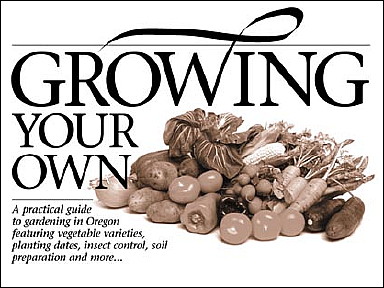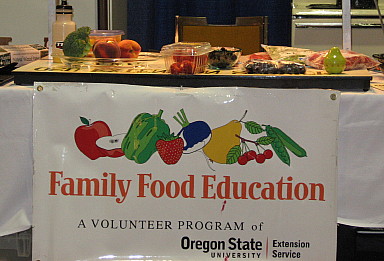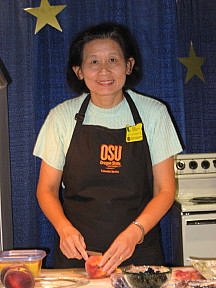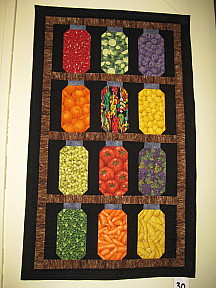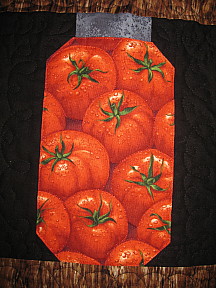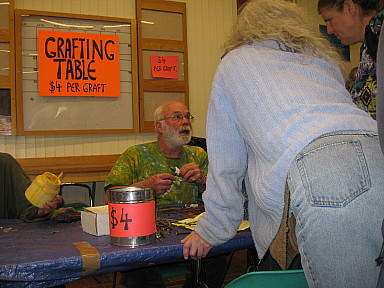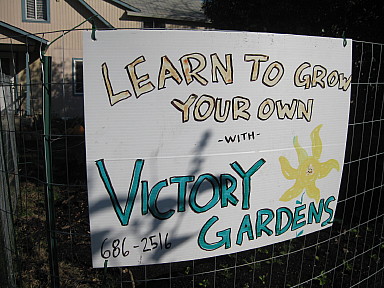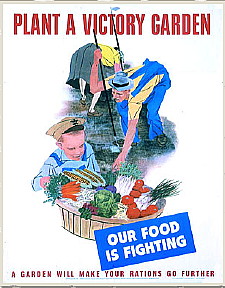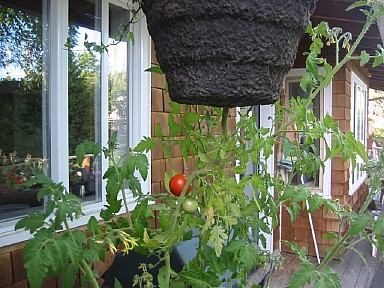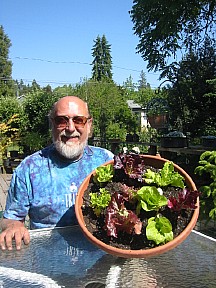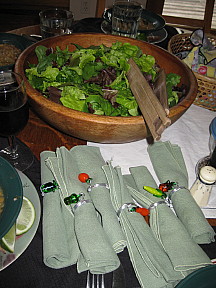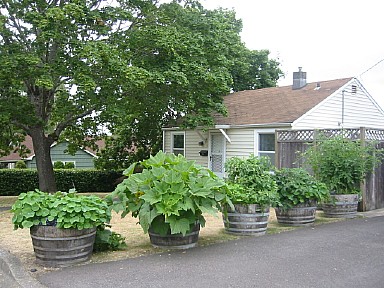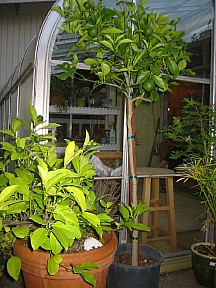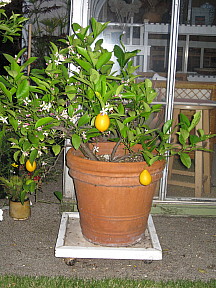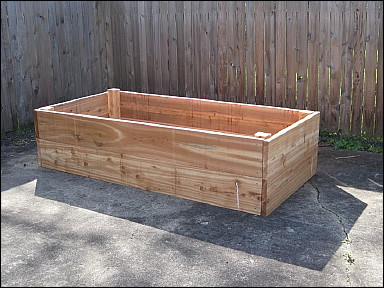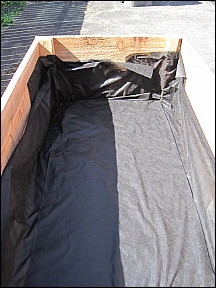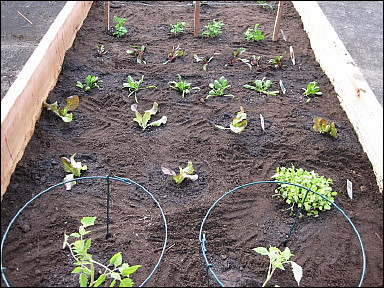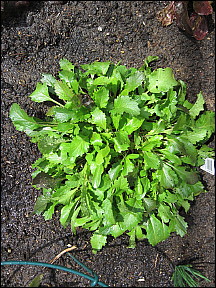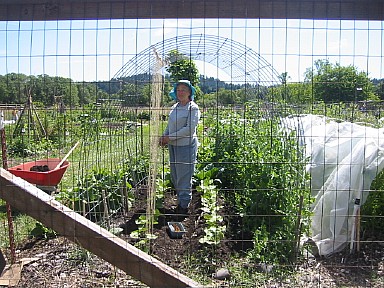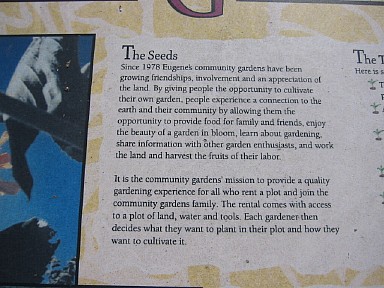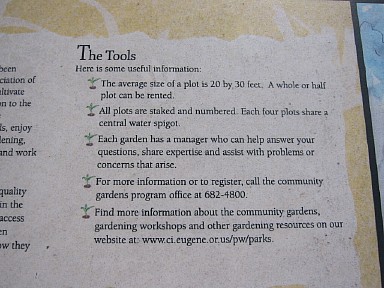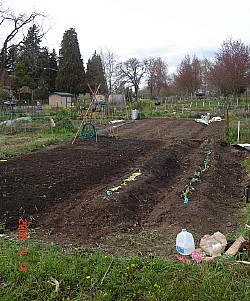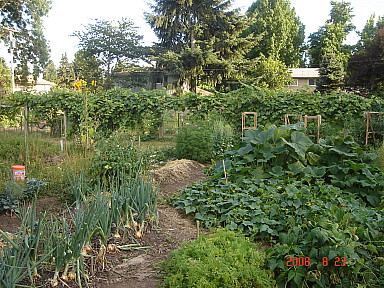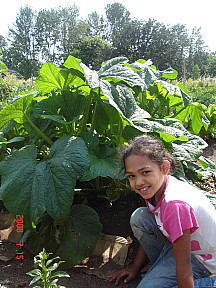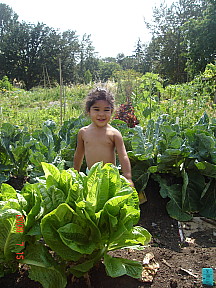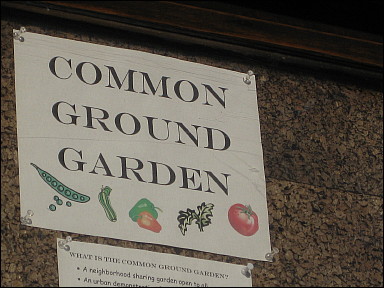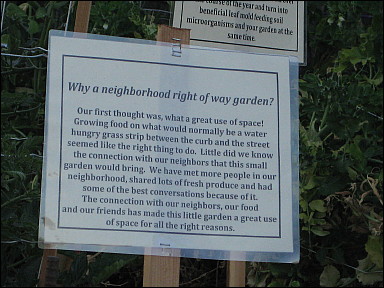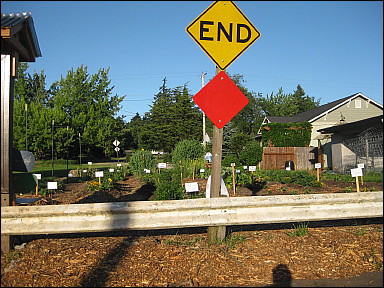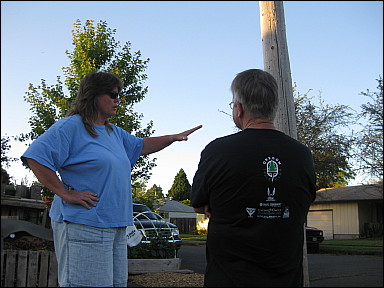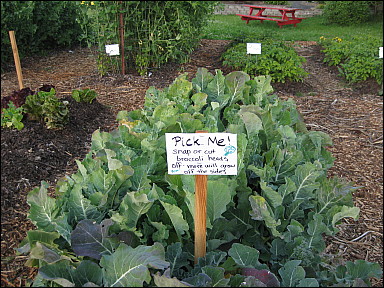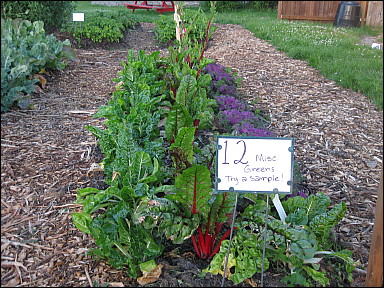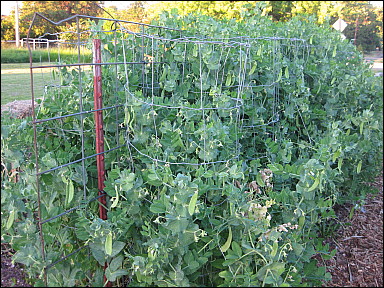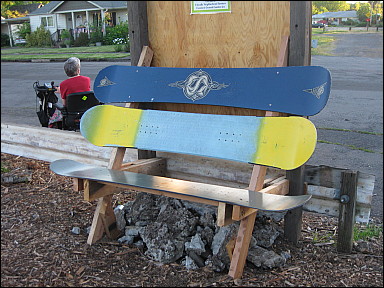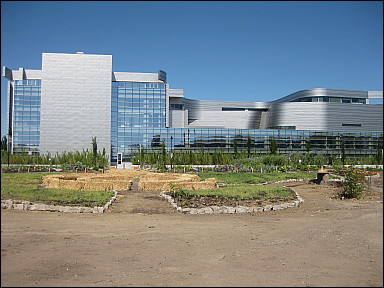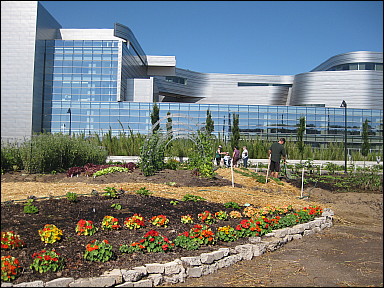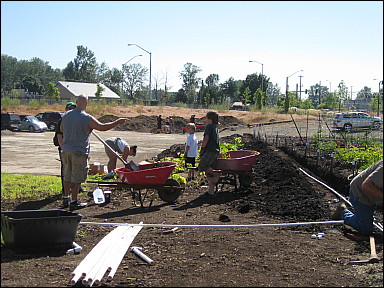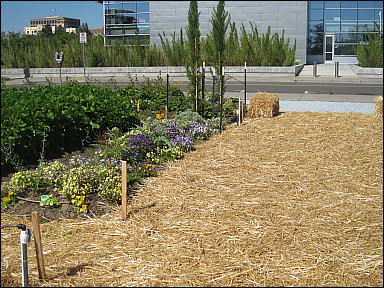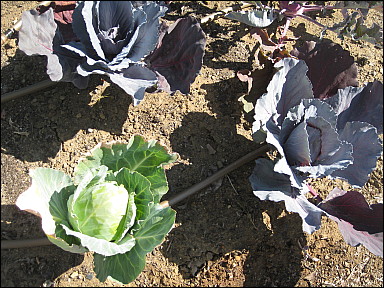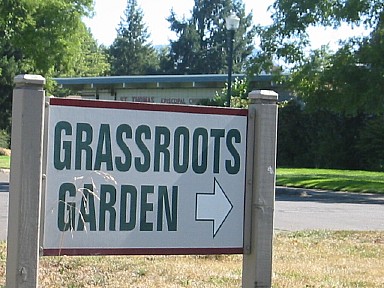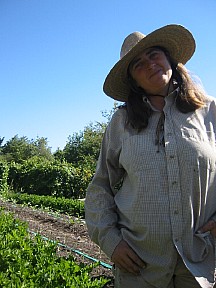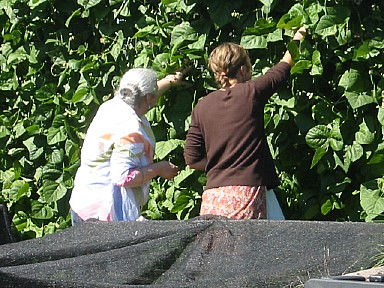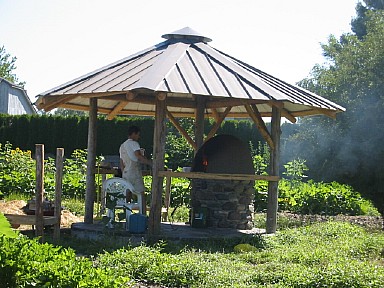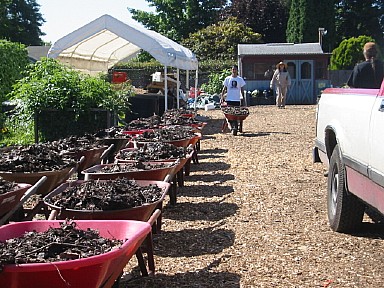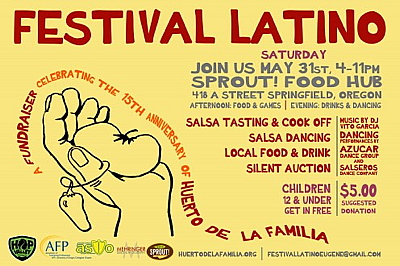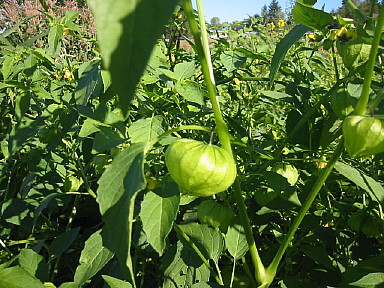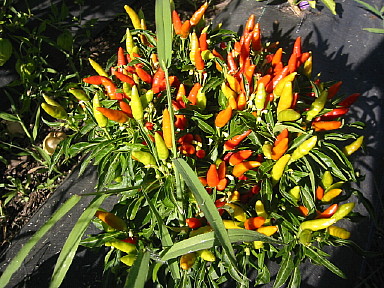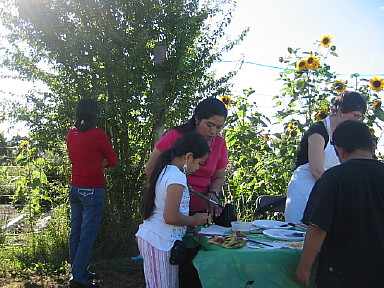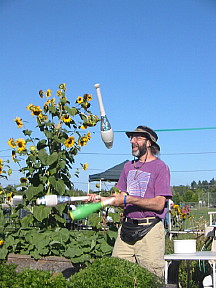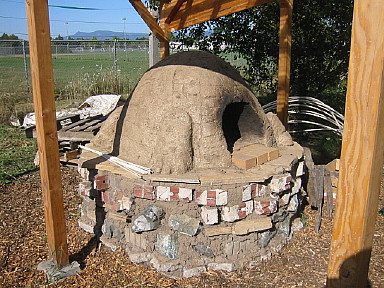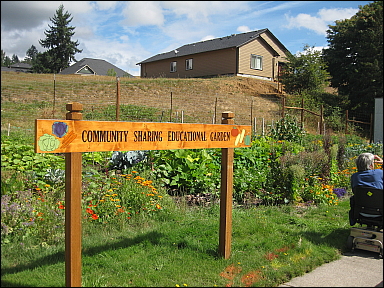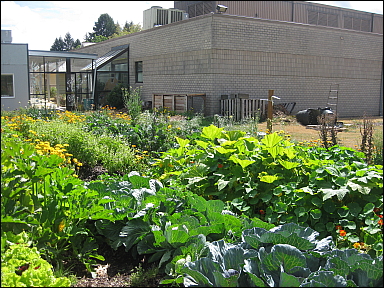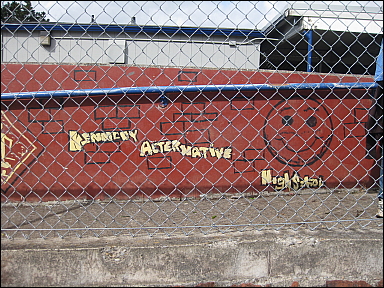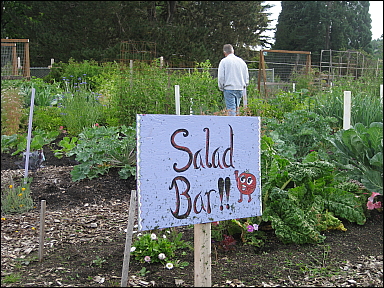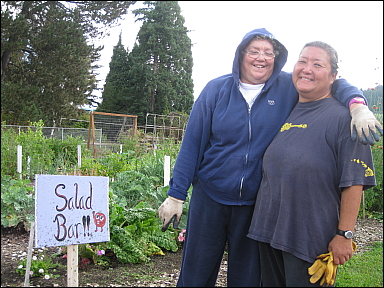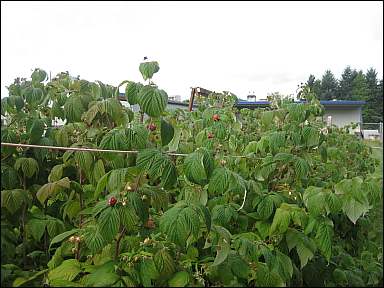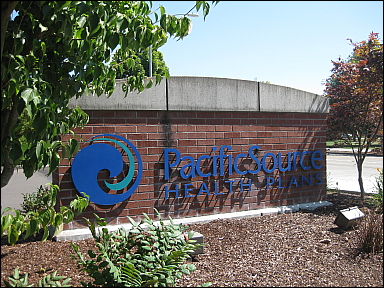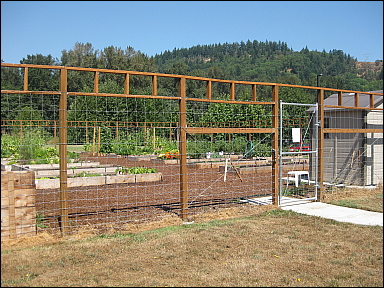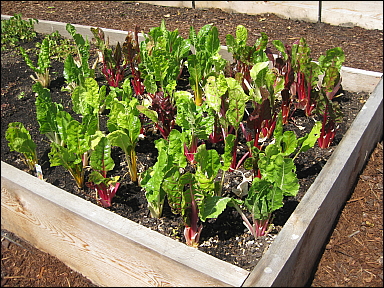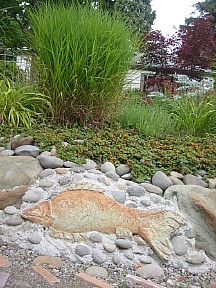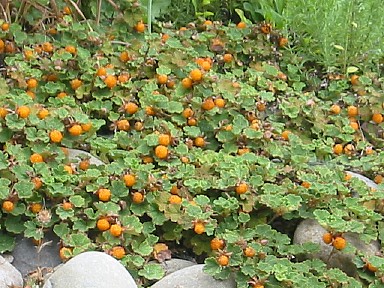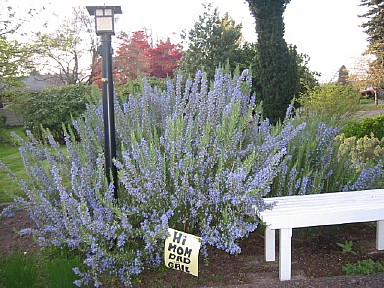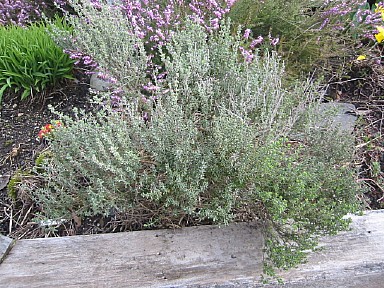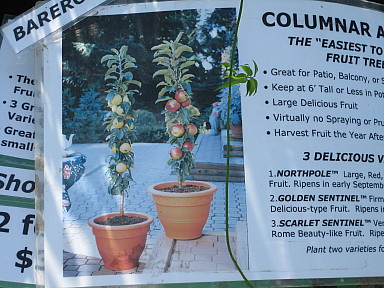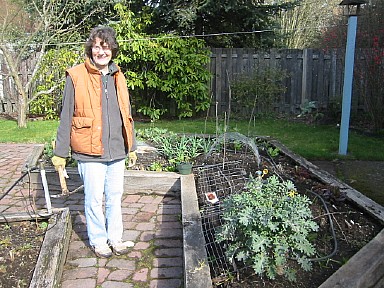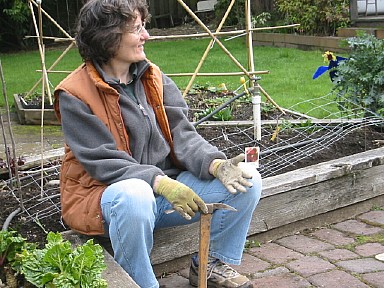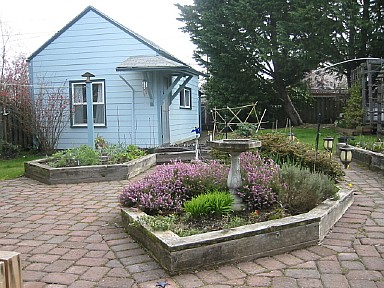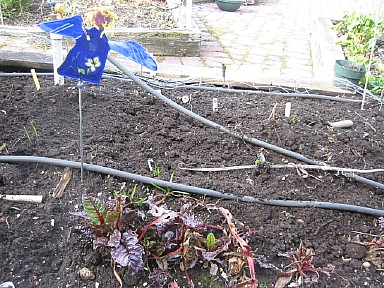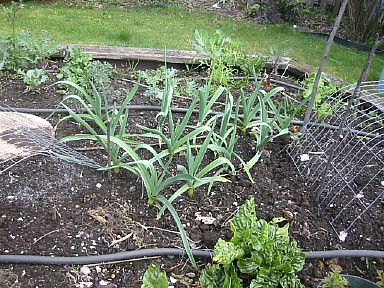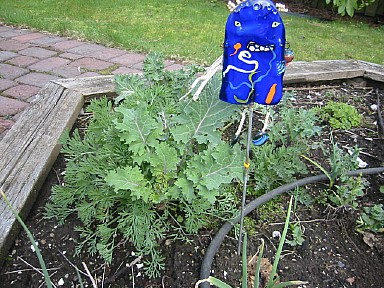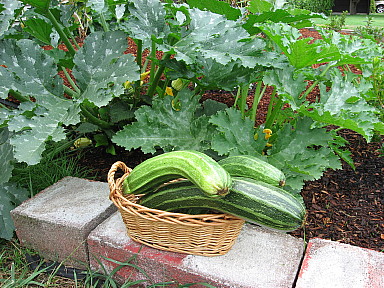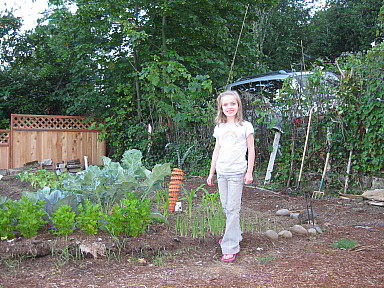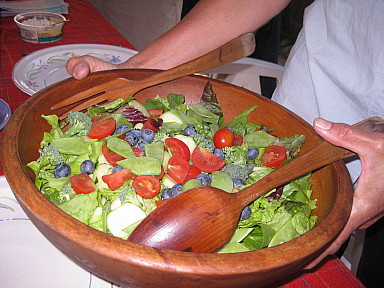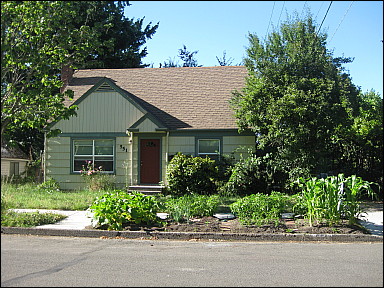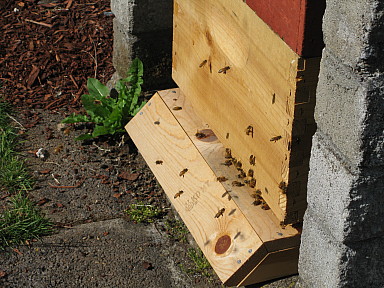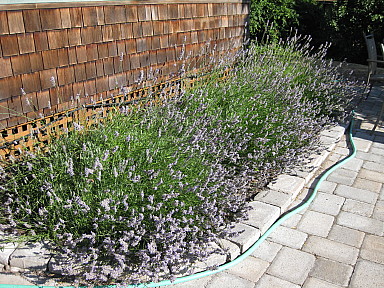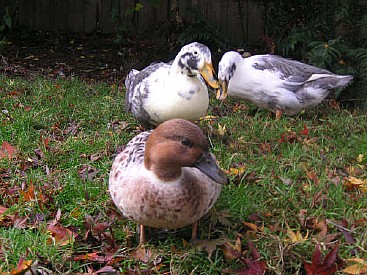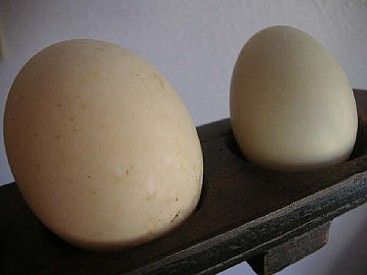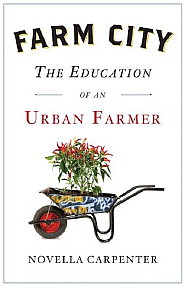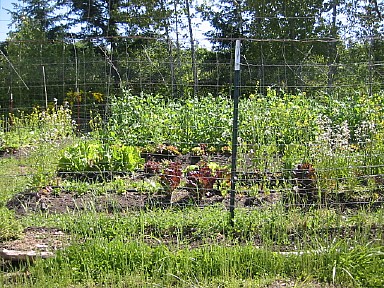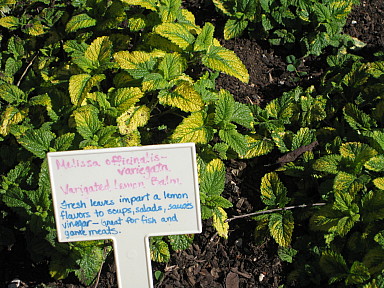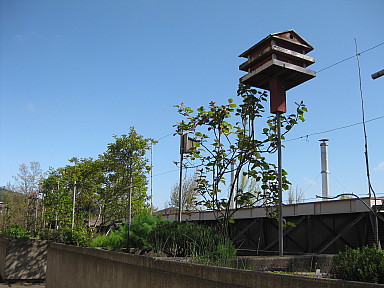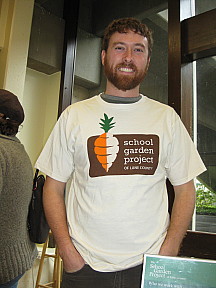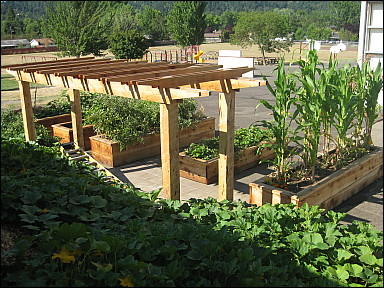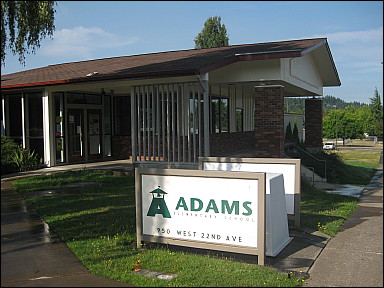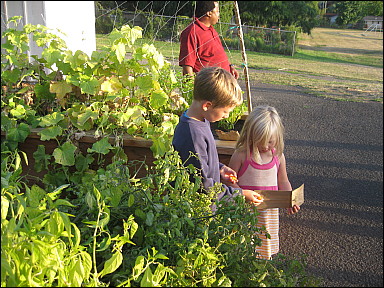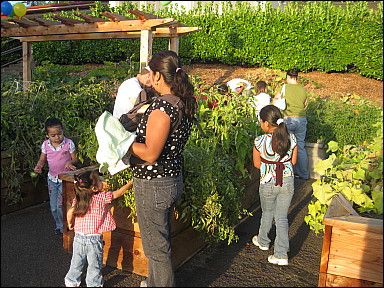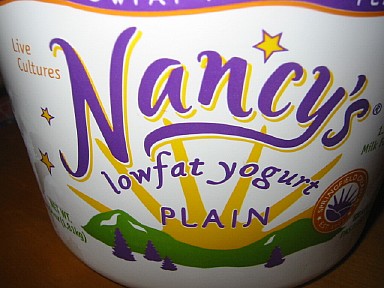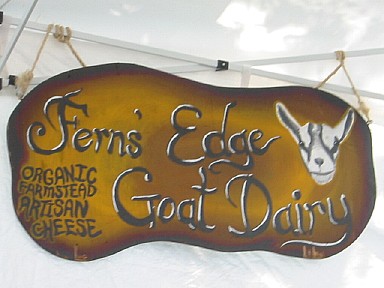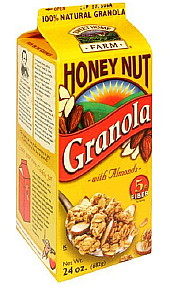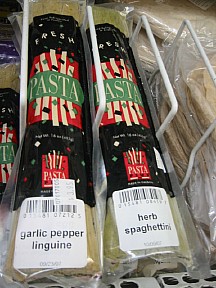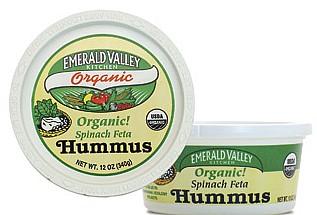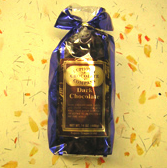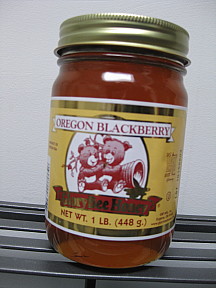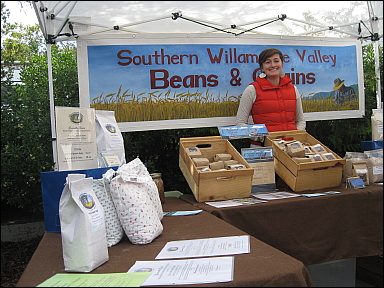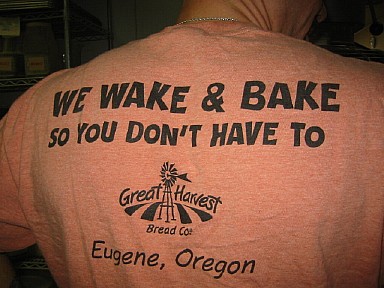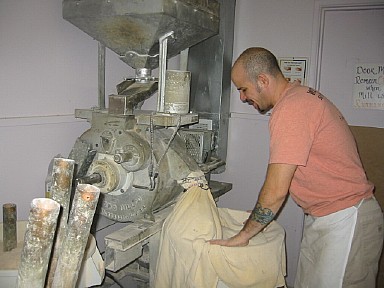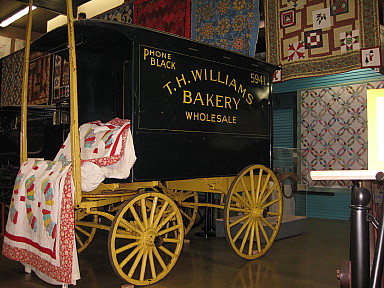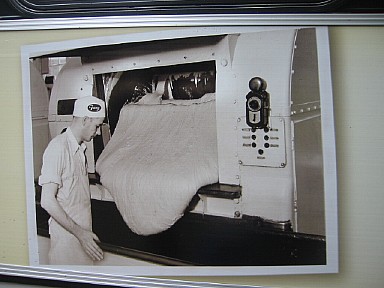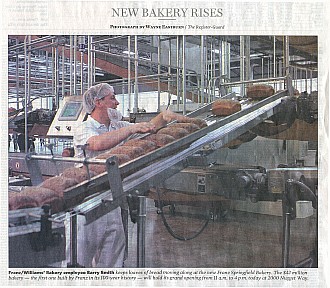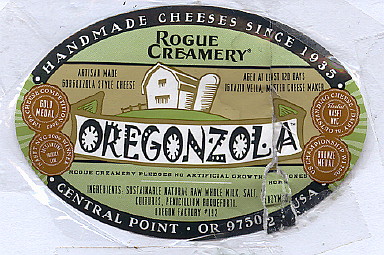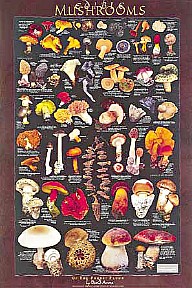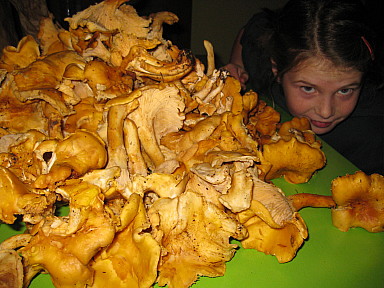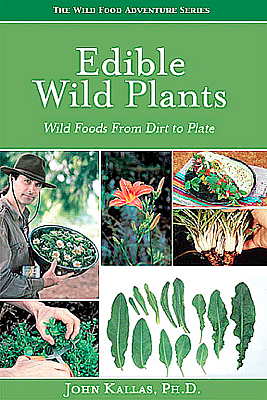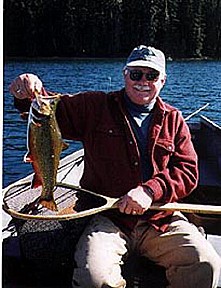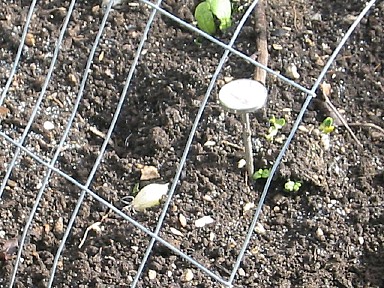
She uses an
inexpensive oven thermometer to tell when her soil
is warm enough to plant seeds.
|
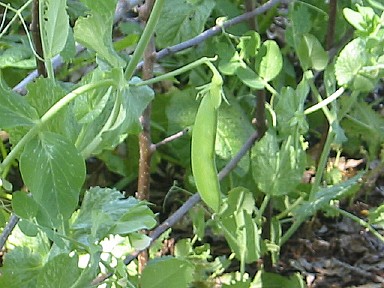
My friend, Babs,
plants pea pod seeds on about Valentine's day and
harvests them for most of the spring.
|
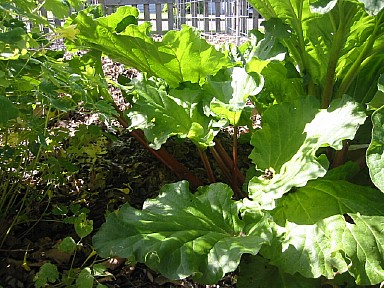
Babs' rhubarb in the
spring
|
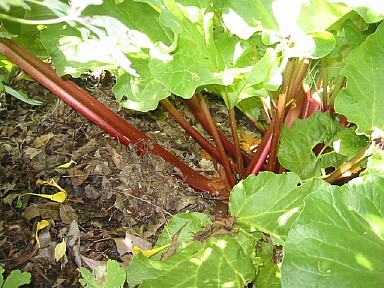
|
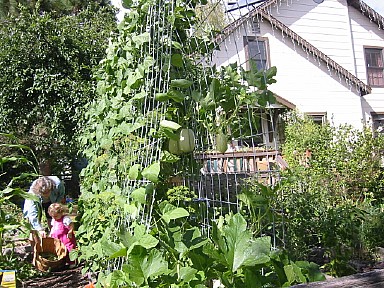
Here she is in
August with her granddaughter, Delaney, harvesting
green beans. That's spaghetti squash climbing
along with the beans.
|
Noy, pictured earlier on this page, has great
success with her home garden.
Taylor's mom took one of our nutrition classes back
when Taylor was born and Camille is now a registered
nurse working at RiverBend Hospital.
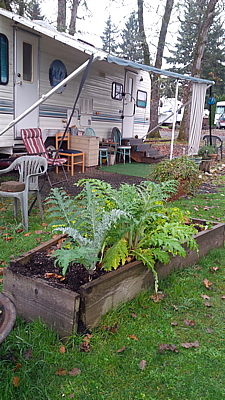
A student named
Lisa sent this picture of her garden in the fall.
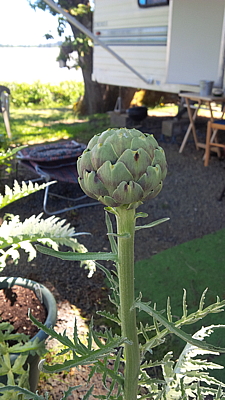
This was one of
her artichokes a few months previously and below
her red hot chili peppers.
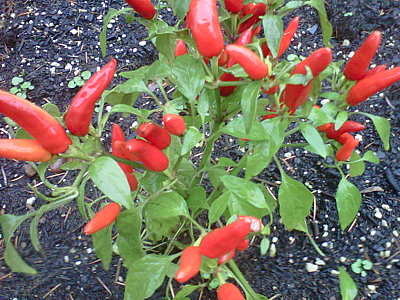
Pam brought this salad made entirely from produce
from her backyard garden.
Some call this a "boulevard garden".
|
Urban farmers are raising their own bees and
getting honey. Our neighbor just installed a
hive where a former owner kept their garbage can.
|
The bees are loving our lavender, which blooms
for weeks, and I'm anxious to find out if their honey
will be lavender-scented.
|
Lane County Beekeepers
Association
Urban farmers are also raising chickens.
|
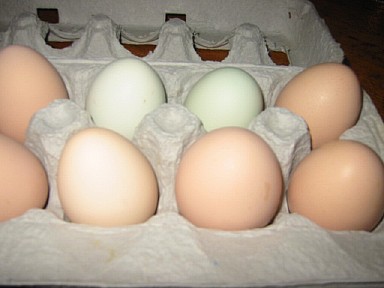
A student named
Diane brought me these eggs from her chickens that
she raises at her house on the outskirts of
Eugene.
In her book, Animal,
Vegetable, Miracle, I enjoyed Barbara
Kingsolver's description of the eggs from her
daughter, Lily's, chickens.
"The products
from her different breeds of hens crossed a
palette from soft green to pink, tan and chocolate
brown. Lily arranged them so every carton
contained a rainbow...."
There's a great website that accompanies the
book:
http://animalvegetablemiracle.com/
|
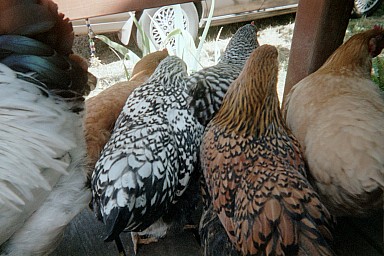
|
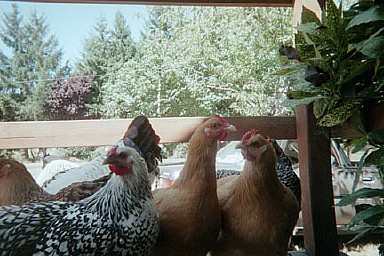
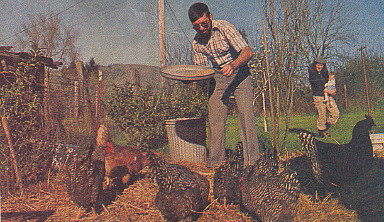
Here's Guy Plaa at
his home in Goshen in 1982. He was a chef
instructor in LCC's culinary program for many years.
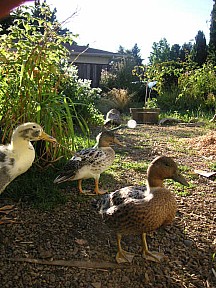
Evan, another
student, raises ducks at his home.
Here's what two of their eggs look like. The
smaller egg is the size of a chicken egg but it is
actually from their smaller breed, the bantam silver
Appleyard.
For more information, you can visit what Evan posted
with the website Local Harvest: Boondockers
Farm.
e.
Apartments, etc.
Some living
situations like apartments have space for
gardening. Ya-Po-Ah Terrace
Retirement Apartments are in downtown
Eugene at the foot of Skinner's Butte and they
have 35 gardeners.
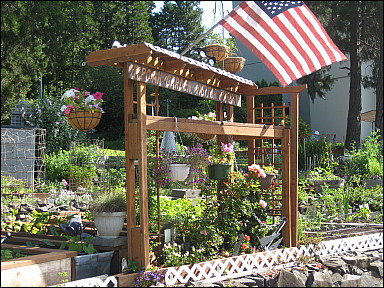
Off to the right
you can see an 83-year-old who has been gardening
there for over 10 years.
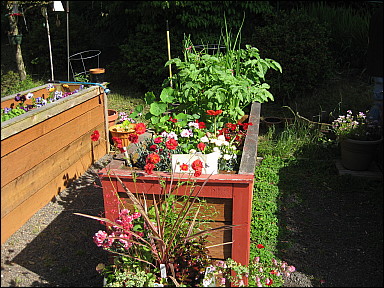
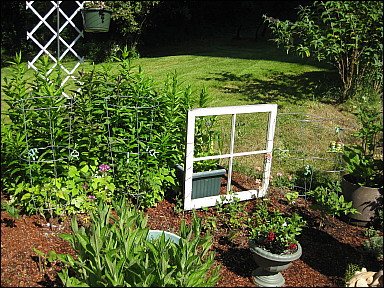
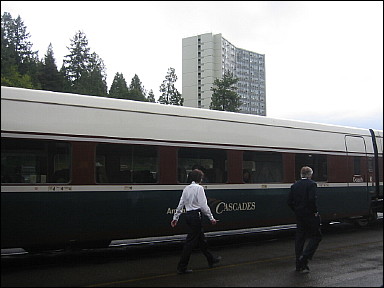
Ya-Po-Ah Terrace
Retirement Apartments were completed in 1964 with
funds provided by the U. S. Department of Housing
and Urban Development
Novella Carpenter
turned a vacant lot in downtown Oakland into a
thriving farm, raising vegetables bees and a
variety on animals, including chickens, rabbits
and pigs. Powells' Books calls Farm City "an
unforgettably charming memoir, full of hilarious
moments, fascinating farmers' tips, and a great
deal of heart. It is also a moving meditation on
urban life versus the natural world and what we
have given up to live the way we do."
Farm City: The
Education of an Urban Farmer, June 2009.
|
|
LCC Learning Garden
an
education-based experience for students.
The LCC Learning Garden is
located in the southwestern part of the 30th Ave. campus
behind Building 26.
|

Brendon Lynch
coordinated it the day I visited.
|
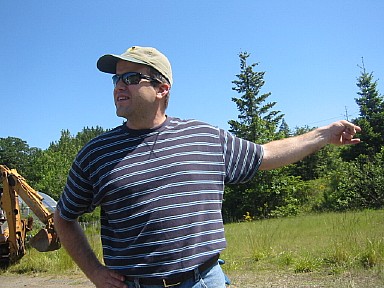
Mike Sims explains
about how food scraps from the cafeteria are
composted and then added to fertilize the soil.
|
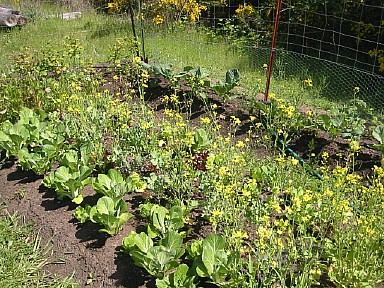
|
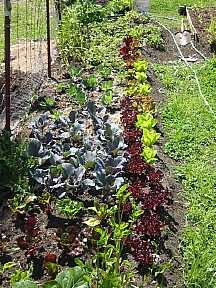
Salad greens from
the garden are used in the LCC cafeteria.
|
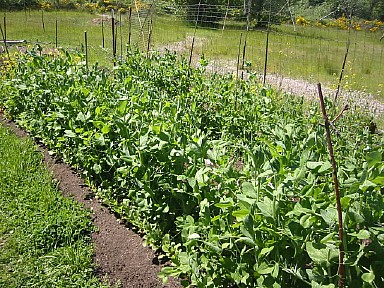
|
|
In addition to the LCC Learning Garden
behind Building 26, there are several herb gardens
located in different places. This one is along
the service road between Building 1 and Building
19.
|
This one is outside the east end of the second
floor of the Center Building.
|
Click here
for more information about LCC's Learning Garden Club.
|
University of Oregon's
Urban Farm
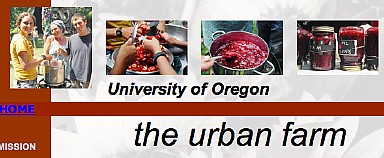
|
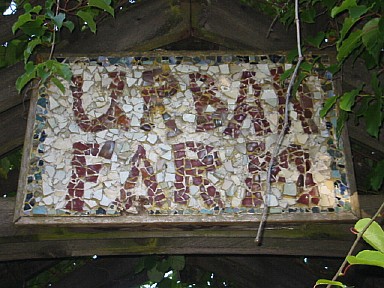
|
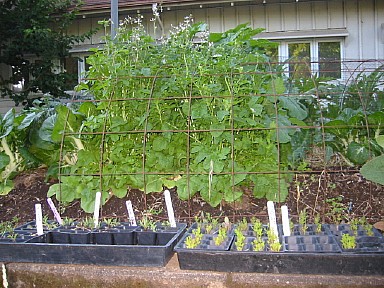
This is arugula, a
wonderful and spicy salad green.
|
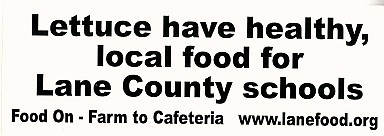
The School
Garden Project of Lane County is a grassroots,
non-profit organization dedicated to fostering
hands-on, schoolyard-based learning experiences for
children by creating vibrant and sustainable school
gardens and habitats.
Jared was at one time the coordinator of the
School Garden Project.
This is the garden at our neighborhood
school.
Willamette Farm and Food Coalition’s
Farm
to School Program received a Victory Against
Hunger award from the Congressional Hunger Center,
Victory Wholesale Group and National Farm to School
Network for its efforts to fight hunger through
promoting and creating farm-to-school programs.
Students in
Springfield Public School's Community Transition
Program have a garden plot at the Food for Lane
County Youth Farm, located on Flamingo Way, near
Game Farm Road. The plan is to be able to sell
vegetable starts and fresh produce at Springfield’s
Farmers’ Market.
Kevin Hillman,
Transition Specialist with the Youth Transition
Program emailed this to me:
"My goals are to provide realistic work experience
to our special needs students as well as support
services in transitioning from school to the adult
world. I also have a personal goal of providing
nutritious food to our school lunch programs."
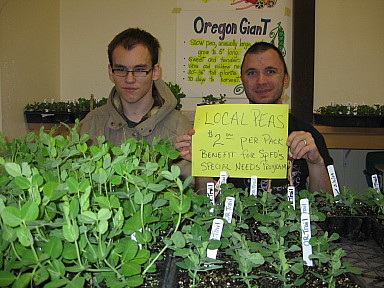 This is Anthony and Danny, two of the high
schoolers in the Community Transition Program,
selling pea starts at the Propagation Fair held in
the spring of 2008 at Lane Community College.
This is Anthony and Danny, two of the high
schoolers in the Community Transition Program,
selling pea starts at the Propagation Fair held in
the spring of 2008 at Lane Community College.
|
The
Willamette Valley
Sustainable Foods Alliance is a regional
association of businesses, located in Lane County,
that promotes natural food businesses through
relationships, education and sustainable business
practices. |
Our area has a long
history of local food products.
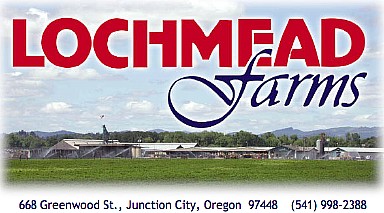
Lochmead
is one of the largest privately owned dairy farms in
the Pacific Northwest. It is still owned and
operated by the Gibson family, who founded it in
1941.
|
Nancy's Yogurt-
began making yogurt in Springfield in 1970 and they
bought Genesis Juice in 2007.
"Genesis Juice to
be revived again", by Joe Mosley, The Register-Guard,
June 21, 2007.
The Dairy Farmers of Oregon maintain a list of
other
Oregon
Dairy Processers.
|
Golden Temple
Bakery, founded in 1972 and now part of
Hearthside
Foods, makes granola using only
organically-grown oats as well as other
organically-grown ingredients. It is available
in many grocery stores.
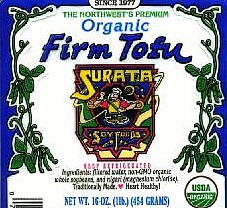
|
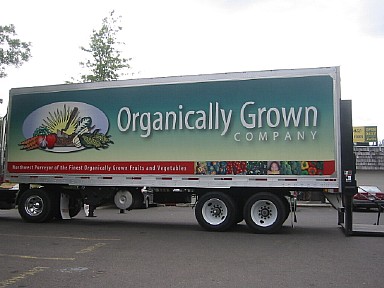
Organically Grown Co-operative, founded in 1978,
opened it's first dock in 1983 and its first warehouse
in Portland in 1993. The photo of the truck
above is in 2007.
Organically
Grown Company
|
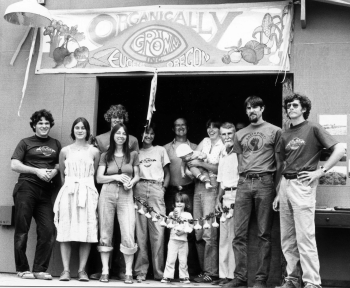
In the center back
are Jack Gray and Mary Jo Wade (holding their first
child, Sam) in the summer of 1983 at OGC grand
opening. Jack and Mary Jo are two of the four
co-owners of
Winter
Green Farm, an early organic farm in Lane
County that is still thriving.
I was in a Birth to
Three group (now
Parenting Now!)
with Mary Jo and Sam and we had several meetings at
their farm. They introduced me to
Oregon Tilth, an
organization of organic farmers, gardeners and
consumers founded in1974. Tilth offers educational events
throughout the state of Oregon, and provides organic
certification services to organic growers,
processors, and handlers internationally.
You can click on the
above image, or the next two, for larger images.
|
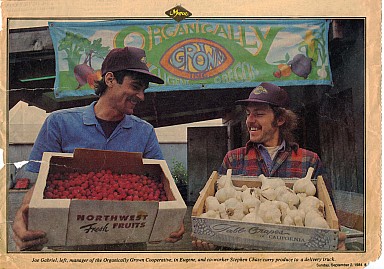
Joe Gabriel (left),
manager of Organically Grown Cooperative in 1984,
along with Stephen Chase.
|
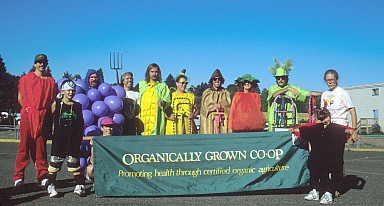
This was taken
during the Eugene Celebration parade in about 1989.
|
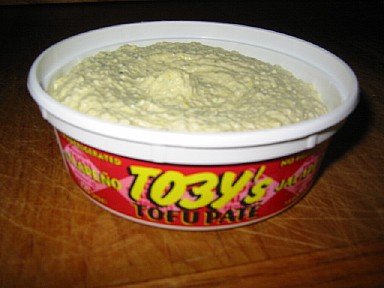
Toby first began
making tofu paté in the late seventies at The
Oregon Country Fair.
Toby's
Family Foods
|
Pasta Plus
began operation in Eugene in 1982.
|
|
|
I have to mention one of my favorite long-time
Eugene food businesses,
Euphoria
Chocolate Company, who started up in the late
eighties. (I'll pretend I don't know that the main
ingredient isn't grown locally.)
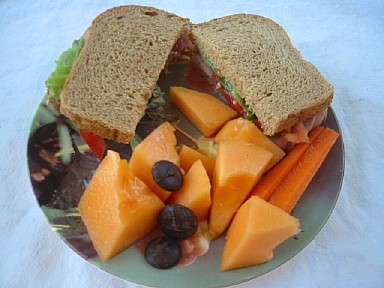
|
Glorybee
Foods started in a Eugene family's garage in
1975. Their honey is delicious.
|
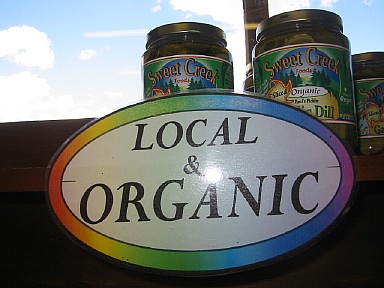
Sweet Creek
Foods is a relatively new company that makes
preserved organic products (including different
pickled items, fruit spreads, salsas and albacore
tuna) that are packed in glass jars.
|
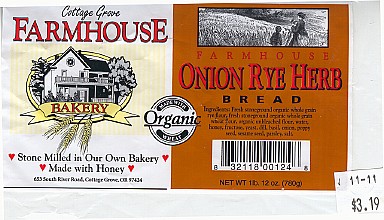
We have a selection
of local bakeries. This one mills their own
flour, although it could be their grains are not
local. The
Southern
Willamette
Valley Bean & Grain Project is working to
stimulate the cultivation and marketing of flour
made from local organically-grown grains.
|
Great Harvest
Bread Co. makes bread in Eugene, but it's a
Montana company.
|
They also grind their own flour in some of their
bakeries, like in this south Eugene location.
|
The oldest bakery in Eugene is William's Bakery,
established in 1908. (The above wagon is at the
Lane
County Historical Museum, shown during a Pioneer
Quilters show.)
|
On an LTD bus recently, I saw the above photo as
part of an ad for Franz bakery, whose over
100-year-old Portland corporation,
United
States
Bakery, bought William's in 1991. Products
made at their new (2006) Franz bakery facility in
Springfield are marketed under a variety of original
bakeries' names, such as William's and McKenzie
Farms. It would be wonderful if they offered a
bread using organically grown grain.
Under the above photo on the bus, it said:
"To last 100
years, you knead a lot of dough."
This Wayne Eastburn photo in an August, 2006
edition of the Eugene
Register-Guard, shows the inside of the
Springfield Franz facility.
|
|
Other Eugene bread
bakeries:
- La Petit Bakery and New Day Bakery at 449
Blair Blvd.
- Metropol Bakery in the 5th Street Public
Market building at 296 E. 5th and 2538 Willamette
- Napoli Restaurant and Bakery at 686 E. 13th
- Palace Bakery at 844 Pearl Street.
-
Sweet
Life Patisserie, 841 W 8th Ave.
- Bread Stop, wholesale baked products
"No loafing pays off for baker", By Joe Mosley
The
Register-Guard, September 14, 2007
|
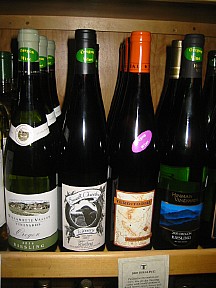
|
This fabulous and award-winning cheese is made just
a little south of here.
|
9. Restaurants
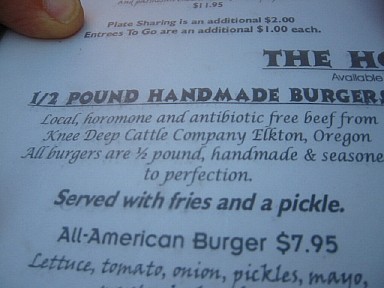
|
10.
"Free"
Food
and Edible Nature
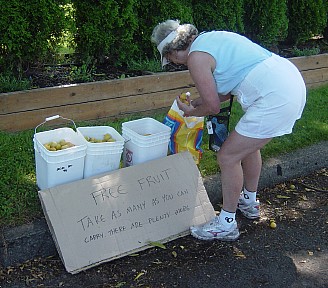
Neighbors often
have more fruit than they can use.
This sign says "FREE FRUIT. Take as many as you
can carry. There are plenty more."
|
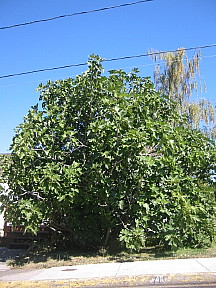
The owners of this
fig tree in Eugene didn't appreciate it when
people came by and took ALL of the low-lying fruit
off this tree.
|
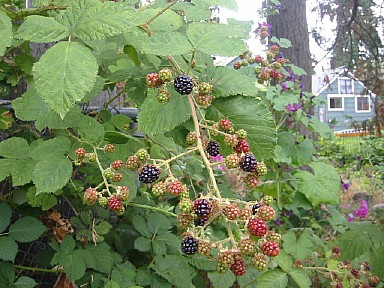
"Alley Cruisin'" in August for breakfast.
|
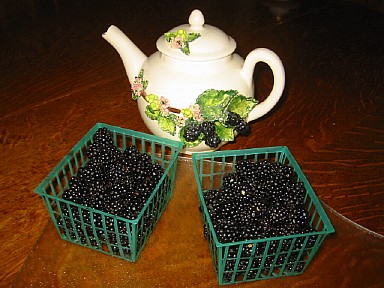
What most of us know as blackberries are not native
here, but were introduced in about 1850.
While blackberries are at the top of
Oregon's invasive weed list, they are also a very
healthful berry full of nutrients, antioxidants and
other phytochemicals. Some maintain that they are
among the state's most promising farm crops.
|
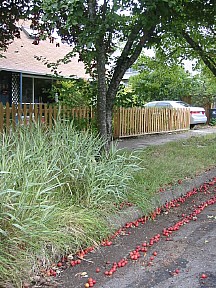
I think these are
plums.
|
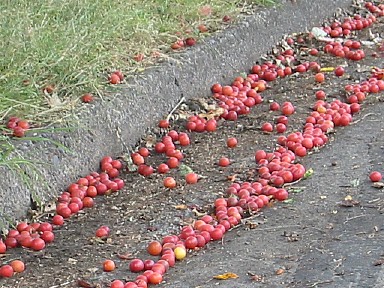
|
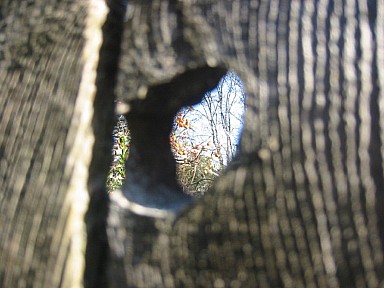
And these are
persimmons in November.
|
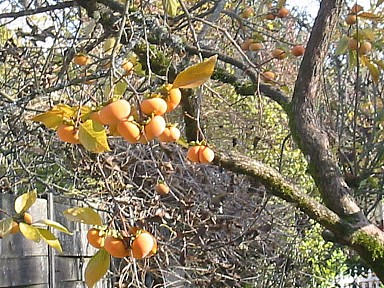
|
The Cascade Mycological
Society is a group of local people who
share a common interest in and appreciation of our
mushrooms.

In late fall, the Cascade Mycological Society co-sponsors
a Mushroom Festival at
Mount Pisgah
Arboretum.
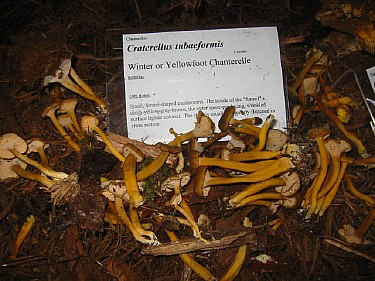
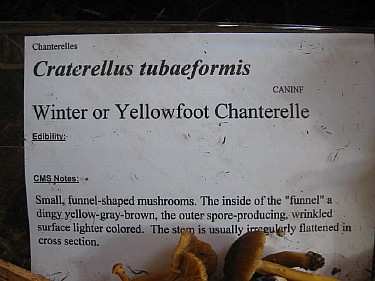
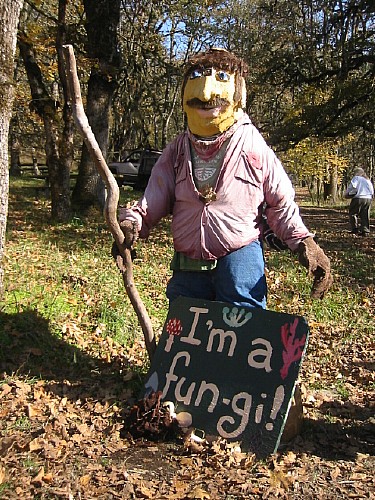
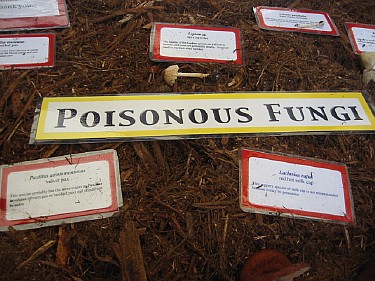
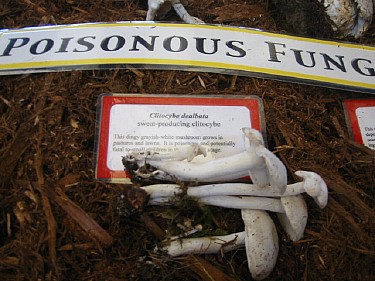
Grace gathered wild chanterelles near Cottage Grove
with a person who had taken a mushroom identification
class.
The article about professionals called "The Mushroom
Hunters" (by Burkhard Bilger, The New Yorker,
August 20, 2007) begins:
"Two hours east of
Eugene, Oregon, in the shadow of the southern
Cascades, the forests begin to thin. It’s the kind
of land that only a mushroom could love."
New Yorker
slide show
about hunting mushrooms in Oregon, August 20, 2007
issue.
http://wildfoodadventures.com/
|
This is Marv Clemons, one of my Lane Community
College colleagues, who would probably say this fish
also isn't exactly "free", but I'd like to close with
him anyway.
THE END
|


